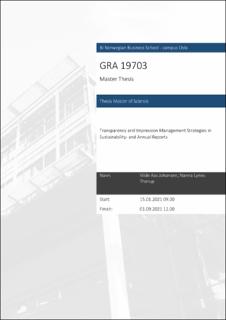Transparency and Impression Management Strategies in Sustainability- and Annual Reports
Abstract
This study applies methods to detect impression management strategies from the
studies of Hahn and Lülfs (2013), Sandberg and Holmlund (2014) and Talbot and
Boiral (2015) in order to critically assess transparency, and greenwashing, on
environmental matters, in Norwegian organisations’ Sustainability Reports (SRs)
and Annual Reports (ARs) throughout the period 2010-2020. The study uses
longitudinal within-case and cross-case analyses, on a sample consisting of 15
organisations, from 6 industries. To determine transparency in the reports, we
conceptualize a measure called ‘level of neutrality’. The level of neutrality
variated significantly within and across organisations and industries. In particular,
the findings revealed that, despite a gradual improvement between 2010-2020,
there is a lack of transparency in most Norwegian organisations’ SRs and ARs.
Additionally, the development of transparency from 2010-2020 seems to be
unrelated to the comprehensiveness of reporting, such as compliance with GRI, as
measured by an Organisational Sustainability Maturity Model. Hence, our
analysis suggests that Norwegian organisations’ reporting practices have had, and
have, greenwashing tendencies. The findings of the thesis align with the critique
of the usefulness of sustainability reporting (Boiral, 2013; Burritt & Schaltegger,
2010; Mähonen, 2020), and substantiate the prevalence of impression
management strategies in sustainability reports (Kanbaty et al., as cited in Hamza
and Jarboui, 2021).
Description
Masteroppgave(MSc) in Master of Science in Leadership and Organizational Psychology - Handelshøyskolen BI, 2021
